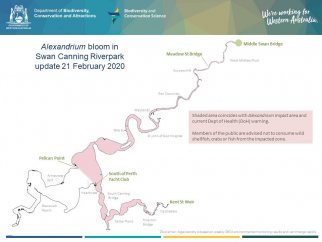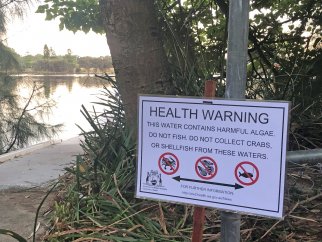SWAN RIVER ALGAL BLOOM UPDATE 01 MAY 2020
Department of Health is reminding people that the warning associated with persisting toxic Alexandrium algal in the Swan and Canning Rivers remains in effect.
Fish, crabs or shellfish collected from within the following waterways should not be eaten due to the potential for unsafe levels of paralytic shellfish toxins:
- Swan River – from Pelican Point, Crawley to the south of Perth Yacht Club, Applecross and upstream to Middle Swan (Reid Highway) Bridge. Middle Swan includes the commonly known areas of Como Jetty, Matilda Bay, Perth Waters, Elizabeth Quay, Barrack Street Jetty, Claisebrook Cove, Maylands Yacht Club, Ascot Waters, Hind Reserve, Riverside Gardens, Garvey Park, Sandy Beach Reserve, Point Reserve, Kings Meadow, Fish Market Reserve and Woodbridge Riverside Park.
- Canning River – from the South of Perth Yacht Club and upstream to Kent Street Weir (this includes commonly known areas of Canning Bridge, Mt Henry Bridge, Salter Point, Shelley Bridge, Riverton Bridge, and Castledare).
For more information, click here.
NOTE: Despite Department of Health signs stating “NO FISHING”, there is no reason why you can’t continue to catch and release fish without any risk to your health in the affected areas.
More information on the algal bloom can be found in these FAQs
A map of the impacted area can be viewed below:

Department of Biodiversity, Conservation and Attractions continues to conduct weekly water quality monitoring at an increased number of sites to track the extent of the bloom.
Mussels, crabs and fish are also being tested for the Alexandrium toxin. DoH and local riverfront councils have arranged for health warning signs advising against eating shellfish, crabs and fish to be erected at key riverfront locations including jetties, boat ramps and key accessible foreshore areas within the affected region.
It should be noted that swimming and other aquatic recreational activities on the Swan and Canning rivers are not impacted by the algal bloom, but as a general rule swimming should be avoided in areas of discoloured water.
